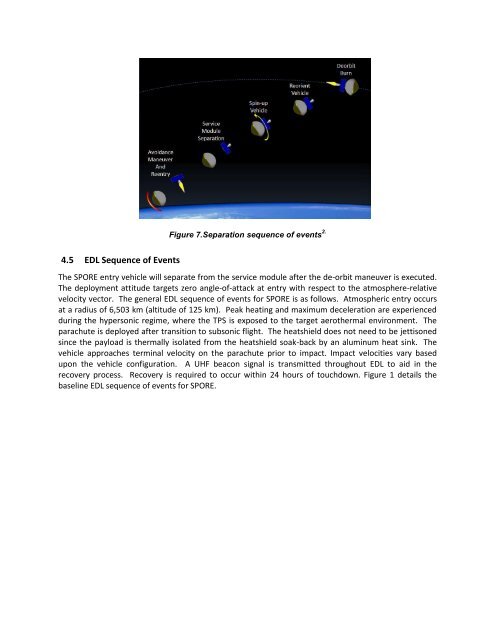SPORE Mission Design - Georgia Tech SSDL - Georgia Institute of ...
SPORE Mission Design - Georgia Tech SSDL - Georgia Institute of ...
SPORE Mission Design - Georgia Tech SSDL - Georgia Institute of ...
You also want an ePaper? Increase the reach of your titles
YUMPU automatically turns print PDFs into web optimized ePapers that Google loves.
Figure 7.Separation sequence <strong>of</strong> events 2.<br />
4.5 EDL Sequence <strong>of</strong> Events<br />
The <strong>SPORE</strong> entry vehicle will separate from the service module after the de-orbit maneuver is executed.<br />
The deployment attitude targets zero angle-<strong>of</strong>-attack at entry with respect to the atmosphere-relative<br />
velocity vector. The general EDL sequence <strong>of</strong> events for <strong>SPORE</strong> is as follows. Atmospheric entry occurs<br />
at a radius <strong>of</strong> 6,503 km (altitude <strong>of</strong> 125 km). Peak heating and maximum deceleration are experienced<br />
during the hypersonic regime, where the TPS is exposed to the target aerothermal environment. The<br />
parachute is deployed after transition to subsonic flight. The heatshield does not need to be jettisoned<br />
since the payload is thermally isolated from the heatshield soak-back by an aluminum heat sink. The<br />
vehicle approaches terminal velocity on the parachute prior to impact. Impact velocities vary based<br />
upon the vehicle configuration. A UHF beacon signal is transmitted throughout EDL to aid in the<br />
recovery process. Recovery is required to occur within 24 hours <strong>of</strong> touchdown. Figure 1 details the<br />
baseline EDL sequence <strong>of</strong> events for <strong>SPORE</strong>.
















